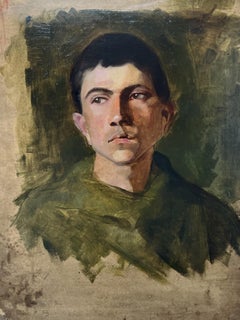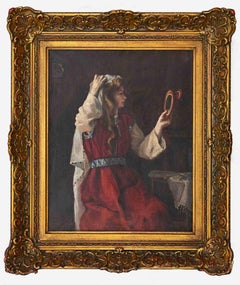Oris Robertson Figurative Paintings
American, 1937-2002
Oris Robertson was born in 1937 in Presidio, Texas, across the border from Ojinaga and Chihuahua. He was a prolific visual artist; Robertson’s family moved to Brownsville when he was 8 and he started drawing and painting soon after, in the mid-1940s. He studied commercial art at Texas Southmost College and earned a degree in fine arts in 1968.
(Biography provided by Reeves Antiques)1
Overall Width
to
Overall Height
to
1
1
1
1
1
1
1
1
1
1
5
462
330
261
214
1
Artist: Oris Robertson
Blue Linear Domestic Family Scene with Two Women
By Oris Robertson
Located in Houston, TX
Beautiful domestic portrait of two women in blue with linear style by Oris Robertson in 1967. Placed in a thin, black frame. Signed and dated in the top left corner.
Artist Biograp...
Category
1960s Modern Oris Robertson Figurative Paintings
Materials
Oil
Price Upon Request
Related Items
French school 20th Century, Portrait of a young man in green, oil
Located in Paris, FR
French school of the 20th Century,
Portrait of a young man in green,
oil on cardboard panel, cradled on the back
53 x 40 cm
This intense portrait is particularly moving and intere...
Category
1950s Modern Oris Robertson Figurative Paintings
Materials
Oil
$1,087
H 20.87 in W 15.75 in
A Young Oriental Woman Looking at the Mirror-Oil on Canvas - 19th Century
Located in Roma, IT
A young woman is an original modern artwork realized in Late 19th Century.
Mixed colored oil on canvas.
The artwork depicts a young woman with veil and mirror.
Unreadible signatur...
Category
19th Century Modern Oris Robertson Figurative Paintings
Materials
Canvas, Oil
$1,418
H 16.15 in W 13.19 in D 0.04 in
Interior with Five Children - Oil Painting on Canvas - 19th Century
Located in Roma, IT
Interior with Five Children is an original oil painting on canvas applied on panel.
This painting has been realized between the end of the 19th century ...
Category
19th Century Modern Oris Robertson Figurative Paintings
Materials
Canvas, Oil
$1,064
H 15.75 in W 11.82 in D 1.19 in
Study of Man - Oil Paint attributed by Marcello Dragonetti - Late 19th Century
Located in Roma, IT
Study of man is an original artwork realized in the late 19th Century and attributed to the painter Marcello Dragonetti.
Mixed colored oil paintig on canvas.
Titled and signature ...
Category
19th Century Modern Oris Robertson Figurative Paintings
Materials
Oil
$1,674
H 14.38 in W 15.16 in D 1.19 in
Portrait - Oil Painting by Pietro Alimonti - 1969
Located in Roma, IT
Portrait is an artwork realized by Pietro Alimonti , 1969.
Oil on Canvas.
38 x 48 cm ; 64 x 54 cm with frame.
Handsigned in the lower right margin.
Good conditions!
Category
19th Century Modern Oris Robertson Figurative Paintings
Materials
Oil
$657
H 25.2 in W 21.26 in D 0.79 in
1945 Portrait of Bessy Lyon by Hayes Lyon, Mid-Century American Oil Painting
By Hayes Lyon
Located in Denver, CO
This captivating 1945 oil portrait by renowned American artist Hayes Lyon beautifully depicts Bessy Lyon, the artist’s wife, in a warm and intimate composition. Rendered with soft ye...
Category
1940s American Modern Oris Robertson Figurative Paintings
Materials
Oil, Canvas
$1,550 Sale Price
51% Off
H 35.25 in W 29.25 in D 1.75 in
Grand Prix Racer
Located in London, GB
'Grand Prix Racer', French School, oil on board (circa 1960s). The 'good ole' days' of Formula One racing are depicted in this thrilling mid-century...
Category
1960s Modern Oris Robertson Figurative Paintings
Materials
Oil, Board
Portrait of Giuseppe Garibaldi - Oil Paint - 19th Century
Located in Roma, IT
Portrait of Giuseppe Garibaldi is an original modern artwork realized in the late 19th Century
It represents the "Hero of the Two Worlds", Giuseppe Garibaldi.
Mixed colored oil pai...
Category
19th Century Modern Oris Robertson Figurative Paintings
Materials
Oil
$2,870
H 29.14 in W 23.23 in D 1.19 in
The Cyclists Rest Stop in Honfleur
Located in London, GB
'The Cyclists Rest Stop in Honfleur' by Jean-Marie Luc Blanpain, oil on canvas (circa 1970s). The artist's depiction of the terrace of the well known Honfleur restaurant, 'Au Relais ...
Category
1970s Modern Oris Robertson Figurative Paintings
Materials
Canvas, Oil
Seated Woman
By François Diana
Located in London, GB
'Seated Woman', oil on board, by François Diana (circa 1970s). This work of sumptuous colour and sensuous subject matter elicits an immediate response. ...
Category
1970s Modern Oris Robertson Figurative Paintings
Materials
Oil, Board
Modernist Portrait of St. Francis
By Tarmo Pasto
Located in Soquel, CA
Modernist Portrait of St. Francis
Compelling modernist oil on canvas portrait of St. Francis by Dr. Tarmo Pasto (American, 1906-1986). Presented in a taupe painted wood frame. Signed "Tarmo Pasto" bottom right, and titled "St. Francis" bottom center. Image size, 25.5"H x19.5"L.
Dr. Pasto was a long-time contributor to the California art scene, as well as an art teacher and psychologist to many successful artists. He also authored a book on art, "The Space-Frame Experience in Art", published in 1964. He, however, was mainly known to the world for introducing the works of one of his patients, Martin Ramirez...
Category
1970s American Modern Oris Robertson Figurative Paintings
Materials
Canvas, Oil
Portrait of a Man
By Yvonne Guégan
Located in London, GB
'Portrait of a Man', oil on canvas, by Yvonne Guégan (circa 1970s). This is not a portrait of the reclusive billionaire, Howard Hughes. Regrettably, we d...
Category
1970s Modern Oris Robertson Figurative Paintings
Materials
Canvas, Oil
Previously Available Items
Untitled
By Oris Robertson
Located in Houston, TX
Abstract Oris Robertson 1967 painting.
"A prolific visual artist, he started painting and drawing as a boy in Brownsville, Texas in the mid 1940s. He was born in 1937 in Pres...
Category
1960s Modern Oris Robertson Figurative Paintings
Materials
Oil
Untitled
By Oris Robertson
Located in Houston, TX
Large Wonderful Oris Robertson Painting. 1970s.
Category
1970s Modern Oris Robertson Figurative Paintings
Materials
Acrylic
Oris Robertson figurative paintings for sale on 1stDibs.
Find a wide variety of authentic Oris Robertson figurative paintings available for sale on 1stDibs. You can also browse by medium to find art by Oris Robertson in oil paint, paint and more. Much of the original work by this artist or collective was created during the 1960s and is mostly associated with the modern style. Not every interior allows for large Oris Robertson figurative paintings, so small editions measuring 25 inches across are available. Customers who are interested in this artist might also find the work of Lorraine Fox, Gershon Benjamin, and Maurice Kish.

